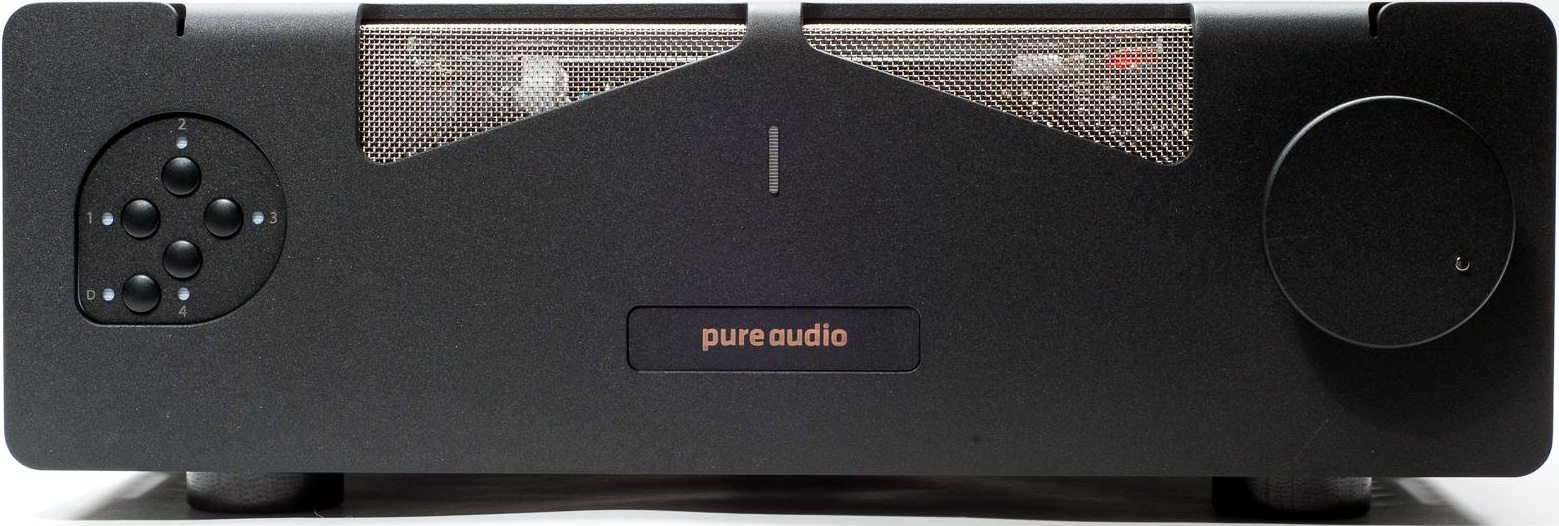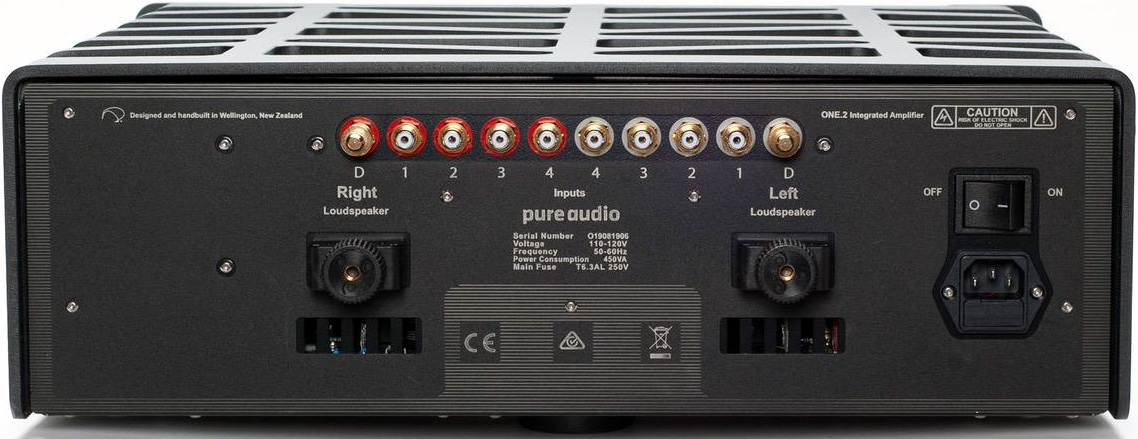I met up with Dave Cope of Old Forge Marketing and Old Forge Studio at the California Audio Show (CAS) in July 2019. Dave is the US importer for Pure Audio, a line of audio equipment amplification from New Zealand. After listening in the room Dave had set it up it was very clear to me that this room was one of the two best rooms at the show. Dave has always shared a similar ear to my own and so I was not surprised that I liked the system he brought to CAS. However, what did surprise me was that he was running a solid-state amplifier and getting a sound that had none of the solid-state nasties to which I have been accustomed for decades.
I went back to the room a number of times to be sure that what I was hearing was this good. The amplifier was the Pure Audio One integrated, and I became convinced that this amplifier had something special going on so I requested a review sample.
The Pure Audio One is a 100 watt Class A dual mono integrated amplifier. It has four line inputs as well as a direct input so it may be used as a dedicated power amp. Co-founder Gary Morrison also sent along their dedicated Control 2 preamplifier, which I will review separately.
The One is a rather large integrated weighing in at 26kg (57lbs) and the partnering remote control is a hefty affair in its own right. The artisanship of the amplifier and the matching remote control is first rate. The One gives the impression of a prestige product that could sit beside far costlier amplifiers. The chassis is made from heavy aluminum and stainless steel mesh. The amplifier runs quite warm, being Class A, so the large heat sinks on both sides of the amplifier with a mostly mesh top allows the heat to dissipate.
Class A amplifiers run hot and soak up a lot of electricity, so does the One. It has an automatic standby mode: if no music signal is being sent, the amplifier will conserve energy until it is woken up by a music signal.
The front panel is minimalist. There is a large smooth volume knob on the right and an input pad on the left for the four inputs and DIRECT IN. There is no power button on the front of the amplifier. On the back, there is a large power switch. The remote control only controls volume up and down. Moreover, Pure Audio uses single-ended (RCA) inputs only, eschewing balanced inputs for reasons they note on their website http://www.PureAudio.co.nz/?page_id=270
Nothing is perfect, so I will get my complaints out of the way.
The back panel layout is perhaps my main gripe about the amplifier. The RCA alignment will require you to separate your RCA cables. The Black and Red are spaced quite far apart as all the black RCAs are aligned in a row on one side, and red aligned on the other. Further, the high quality Cardas speaker connectors do not accept banana plugs, so you will need to purchase adapters if your speaker cables are fitted with bananas. This mystifies me given that bananas are arguably the most common speaker connectors in use today. Fortunately, I had a set of cables with spade/fork connectors just in case this situation arose. I would suggest that Pure Audio include adapters with the amplifier or ensure that dealers stock them. Better yet, look for a high quality 5-way binding post and incorporate that instead.
My last issue is that when you turn the amplifier on, you must always push the SOURCE button. If you are using just one source, the amplifier “forgets” that you were using source 1. Therefore, you must always push the source 1 button. You will forget. You will turn the amplifier on, sit down, and get no sound. Then after you scratch your head, you will say “ahh” and then have to get up and walk over to the amplifier and select number 1. Granted this is probably that bit of exercise most audiophiles need, so the more you forget the healthier you will be. Once you have made your connections you will rarely need to go behind the amplifier and, if you leave the amplifier on in standby mode, you will not need to press the input pad.
Sonic surprise
When I first connected the system and pushed play, I was rather surprised by the valve-like presentation emanating from the amplifier. There was ambiance and depth to my first recording, Loreena McKennitt’s “Lullaby” from her album Elemental, which features Loreena’s vocals overtop of Douglas Campbell’s reading of William Blake’s Prologue intended for a dramatic piece of King Edward the Fourth. One of my complaints about solid state is that it often seems unable to play “gently” and provide an emotional experience with music that should touch your soul. It is usually an abysmal failure in this regard. Yes, solid state can punch you in the kidneys with massive bass slam at obnoxious volume levels, but usually at the expense of delicacy and insight. Thus, I was relieved that the Pure Audio One didn’t manhandle this album and retained the delicacy and allure of Loreena’s vocals and what I often refer to as the “breath of life” that goes missing with a lot of high end audio.
Interestingly, the Pure Audio One sounded more stereotypically “tube” than some tube amplifiers I have auditioned over the years. The fluidity, big tone, ambiance, and portrayal of three-dimensional space should endear the amplifier to tube amplifier fans.
Chantal Chamberland’s “Here Comes the Rain Again” from her album This is Our Time is an excellent recording that, like the Loreena McKennitt, offers a non-digital, you are there experience. With the One integrated, I was hearing big breathy vocals and solid bass lines along with coherency similar to what I remember about my big Line Magnetic 219IA.
- (Page 1 of 2)
- Next page →




Great review Richard. I agree with nearly every point of the review. Of course, you would expect me to since I purchased the one I reviewed. By the way you should hear it drive a pair of ElectrostaticSolution’s QUAD ESL57s.
$10-k audiophile amplifier with no input for the highest quality audio source — vinyl
Fail
It is very expensive to have a separation in the very impractical input connections for order purposes and that does not compromise the sound quality at all. An audio system of that category and not having a high sensitivity input gives much to think, because everything is not power. Signal amplification such as vinyl is a treatment that requires a lot of knowledge of weak signal amplification with very low distortion and noise.
Thanks, Richard, for a very thorough and informative review.
Yes, vinyl is a very important source, but not one that everyone takes advantage of, so why have people pay for something they may not use? Pure Audio certainly recognizes both the importance of vinyl and the challenges involved in doing it justice, and thus offers not one, but two separate phono stages: Vinyl – a $4,000 fully adjustable, moving coil-only phono stage for low-output moving-coils only with killer power supply, and Vinyl 2, (‘Lil Vinyl’), a $1,200, much smaller, less expensive mm and mc phono stage, aimed at a wider, but still demanding audience.
Perhaps Dagogo would be interested in reviewing a Pure Audio phono stage in the future . . .
It’s also important to realise that a phono stage inside a box with high class A current running around and incorporating big power supplies is going to struggle to remain hum free.
They just come out with a improved Pure Audio One.2 Series 2
Can you do a update review ?
No balanced input on a $10K amplifier ?
Hi
Can you tell me who imports this ampiflier in Europe. I would love to listen/test this ampiflier, but i cannot find anything about it in The Netherlands